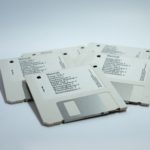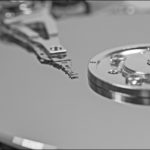Ah, the floppy disk. How I miss thee. How I don’t. There was a certain tactile pleasure to inserting you into your drive, and in the early days, locking you in place. The audible click and/or snap of the mechanism just added to the delight.
Alas, you were too easy to spindle, fold, or mutilate; too slow, and not capacious enough. Not to mention susceptible to data loss when you got too close to a magnetic source. You were certainly better than the tape cassette drive you replaced, but I had to move on, and I can still feel the anguish as I think of the look on your…
Wake up, Jon! You couldn’t wait to move to hard drives when you got the chance. And SSDs in their turn. Stop with the maudlin reminiscing! Okay, I’m back now.
A Brief History of the Floppy Disk
Most people are old enough to have at least passing familiarity with the floppy disk as it appeared in its ultimate 3.5-inch form. I still find them at times discarded on the street. That final incarnation sported a rigid shell that somewhat undermined the validity of the name, but at least the magnetic media inside was floppy. Aside from the rigid hub at any rate.
Before that, there was the all-soft 5.25-inch floppy, and predating that, the massive, even more pliant 8-inch floppy. The latter truly was a floppy, noticeably drooping if you picked it up from the edge. I remember you well. (Stop it!) IBM holds the patents for the technology (applied for in 1969, granted in 1972), though there’s an interesting claim from Japaneses inventor Yoshiro Nakamatsu.
A brief aside: The floppy disk is hardly dead. As with vinyl records, it’s still for sale, and alive and well in the nostalgia and hobbyist market. In a sleep-tight-tonight, your-Air-Force-is-awake moment, as recently as 2016 the U.S Department of Defense was using 8-inch floppies. If it ain’t broke, don’t fix it?
I already described some of the floppy drive’s finer characteristics, but a bit more detail is in order. A floppy disk consists of a sheath or shell harboring a thin disk of polymer coated with a baked coating rife with magnetic particles. It’s written and read with the same type of read/write mechanism used in tape recorders, i.e., a magnetic field is employed to detect or change the orientation of the magnetic particles. This same fundamental technology is employed in hard drives to this day.
Unlike a tape recorder, where the tape slides past a stationary read/write head, the heads on a floppy drive are on an arm that is stepped mechanically across the surface by a motor, reading and reorienting particles in concentric circles, or bands.
8-inch and 5.25-inch floppies had holes like a 45-rpm record and were basically clamped in place by the spindle, while 3.5-inch floppies had a hub with a keyhole that married to a key in the spindle. Think Ghostbusters. Now don’t think Ghostbusters. You can’t, can you?
Floppies could be single-sided, or double-sided, and increased in areal density with each iteration. Basically in the order shown below:
- 1971, first 8-inch floppy: A little more than 80KB
- 1977 8-inch floppy: 1.2MB
- 1976, first 5.25-inch floppy: Around 88KB
- Later 5.25-inch capacities : 360KB, 720KB (double-sided), 1.2MB (High Density)
- 1982 3.5-inch floppy: 240KB/360KB
- Later 3.5-inch capacities: 720KB, 1.44MB (double-sided)
- 1996/97 3.5-inch floppy: 120MB to 240MB–believe it or not
8-inch floppies faded quickly, but 5.25-inch and 3.5-inch usage overlapped for a relatively long period of time. There were a large number or permutations of the 3.5-inch type, and actual capacity could vary by vendor according to how much of the disk was used, the file system, and a number of other factors. The storage and file system was generally proprietary to the vendor or operating system, CP/M, DOS, Apple, etc., though there was some crossover.
The floppy eventually faded from common use as programs and data sets outgrew its now quaint-seeming capacity. The arrival of new or newly affordable, faster, and more capacious technologies such as the hard drive and compact disc didn’t help. A number of other removable media technologies made dents as well, however, you could still find floppy drives on systems well into the new millennia.
So here’s to you old friend, and thanks for saving me from that ridiculously unreliable (wrong resistor) cassette drive on my Atari 400. I’ll be eternally grateful.










